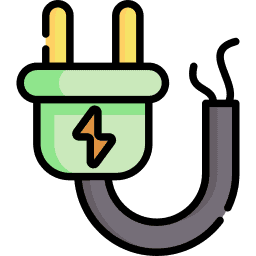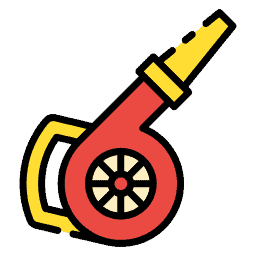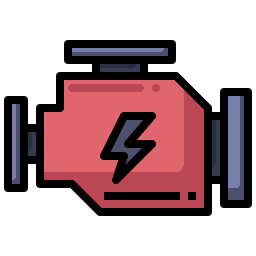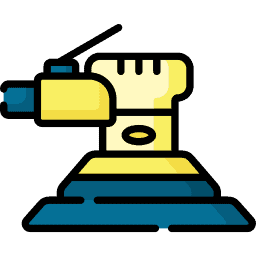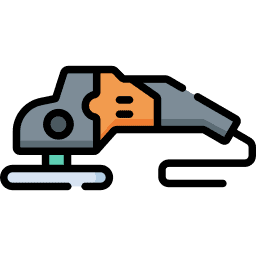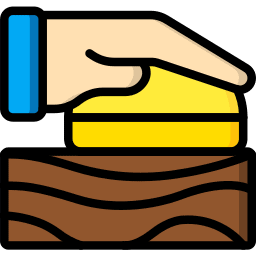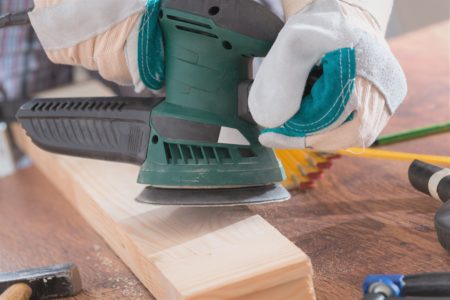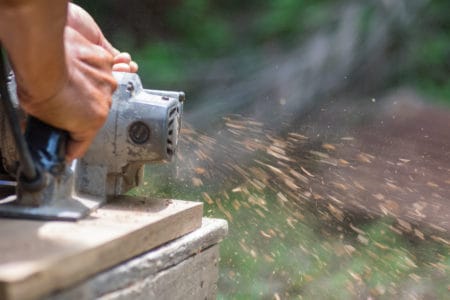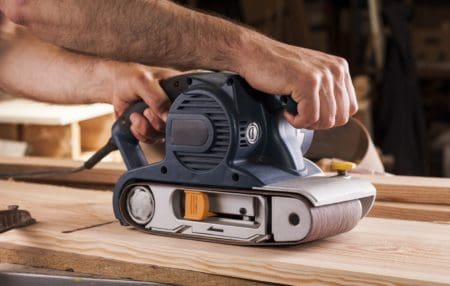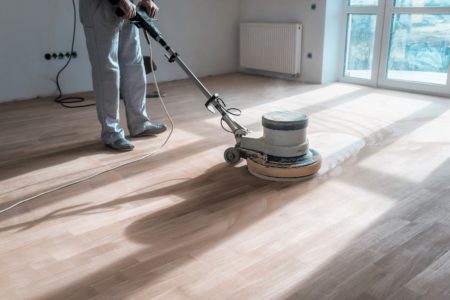Woodworking is all about detail, so why waste hours hand-sanding your project when you could strap a sheet of sandpaper to a palm sander and get the same result in half the time?
We show you the best palm sanders to make your woodworking tasks easier.
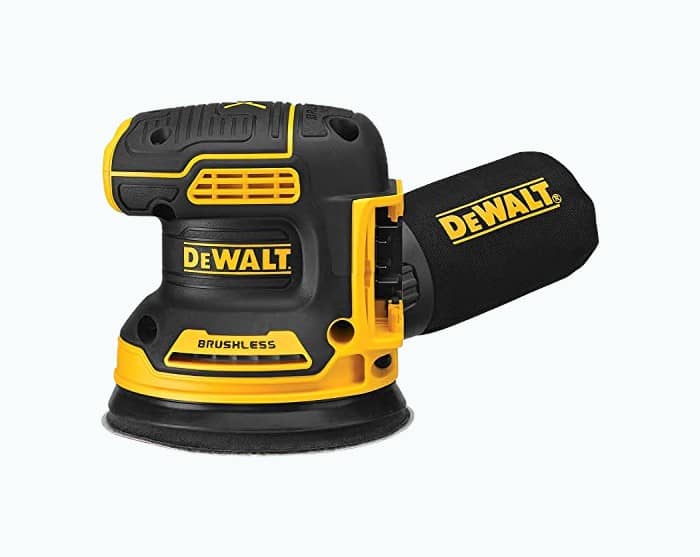
- Battery-operated
- Efficient brushless motor
- Ergonomic rubber-molded grip
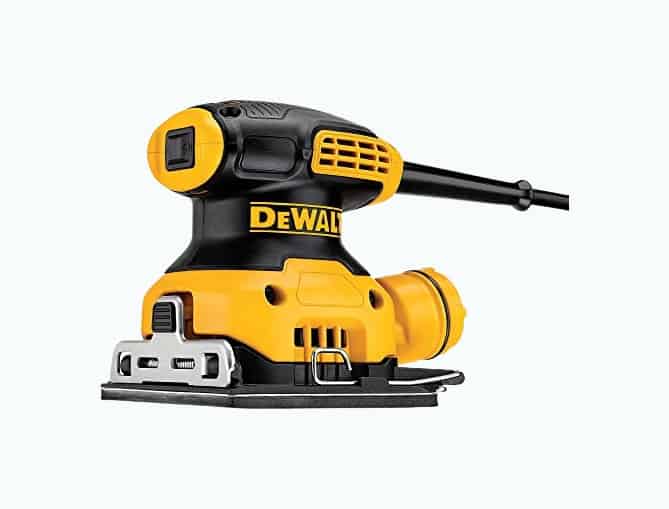
- 14,000 OPM
- Enhanced paper clamp
- Easy vacuum attachment
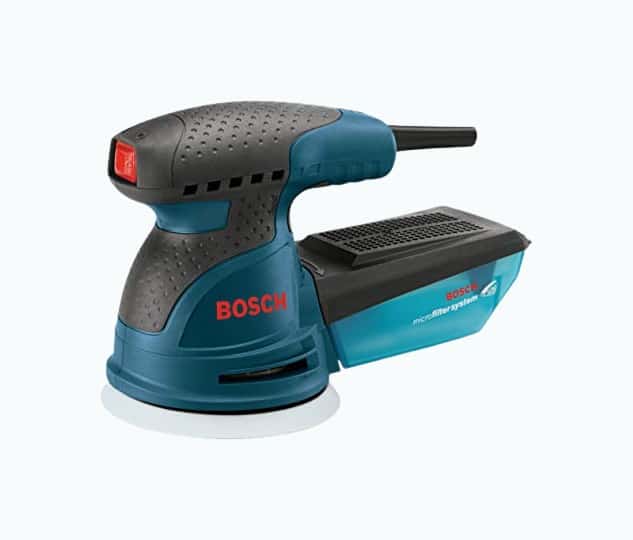
- Anti-swirl technology
- Microfilter dust canister
- Variable speed control
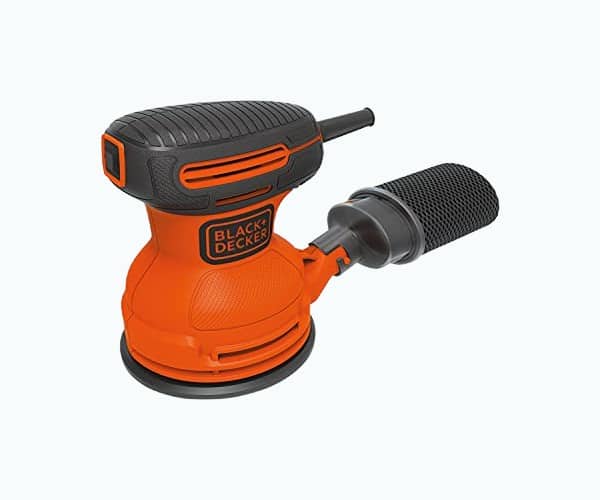
- 12,000 OPM
- Includes a dust port
- Hook & loop system
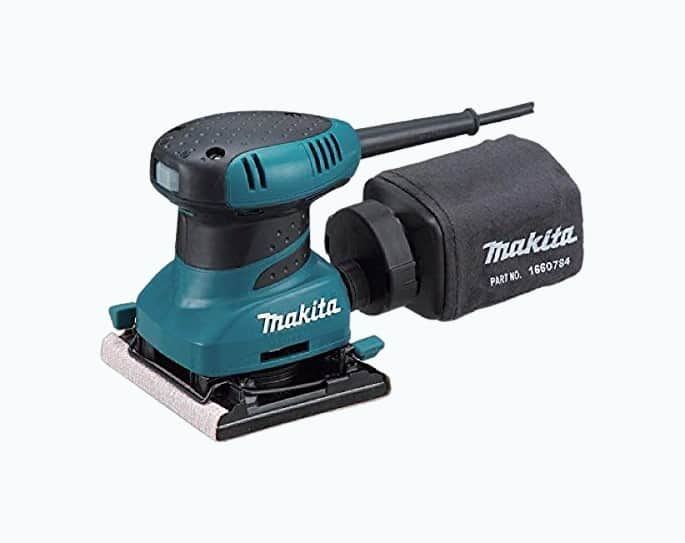
- 14,000 OPM
- All-ball bearing construction
- Contoured & rubberized grip
Review Methodology: At Sensible Digs, we understand the importance of a reliable palm sander for your DIY projects. Therefore, we conduct a thorough comparison and hands-on evaluation of different models based on criteria like performance, design, and user experience. Our professional team measures and ranks each product using data gathered from first-hand testing and assessment. We identify key decision-making factors such as power, durability, dust collection, and handling, providing you with clear, fact-based findings. From these results, we highlight what sets apart the best palm sander from its competitors, helping you make an informed choice. Our review is a benchmark for reliable and objective analysis.
The Best Palm Sanders of 2024
Finding the perfect palm sander takes time and research. We scoured the internet to bring you our take of the 5 best palm sanders.
DeWALT DCW2108 20V Orbital Sander
Best Cordless Palm Sander
This palm sander has the lot. It has variable speed, an ergonomic rubber-molded grip for better control and comfort, plus, a brushless motor to ensure longer battery life and enhanced efficiency.
You can choose to connect the sander to the dust collection bag or link it up to a central dry vacuum to remove the sawdust. This cordless palm sander has a maximum of 20 volts, giving it a maximum OPM of 12,000, which is enough to tackle the toughest tasks.
The replaceable hook and loop pad makes disc changing a breeze, and the lightweight construction reduces hand fatigue during prolonged spells of usage.
The only downside is you have to buy the battery and charger separately, which adds to your cost.
What We Like
Battery-Operated
This palm sander is a go-anywhere tool. Take it to the construction site, outside in the yard, and even to the cabin in the woods, and it works. It frees you from the shackles of electrical sockets and power cords.
Efficient Brushless Motor
If you are considering a cordless palm sander, a brushless motor has to be a priority. They increase the efficiency of the tool, which gives you a longer runtime between each charge.
Lots of Features
You get variable speed, so you can adjust between 8,000 to 12,000 OPM. You also get an ergonomic molded grip to increase comfort and decrease hand and wrist fatigue. Couple that with the fast-change sanding pads, and you have a useful tool.
What We Don't Like
Batteries and Charger Sold Separately
Paying extra for the batteries and charger will increase your spend considerably, making this sander less appealing in the value for money stakes.
Product Specs
| Weight (pounds) | 2.5 (Excluding battery) |
| Dimensions (inches) | 8.8 x 5.7 x 6.3 (Excluding battery) |
| OPM | 12,000 |
| Amps | 20 volts (Portable varieties use voltage as an indicator) |
| Dust collector | Yes (Sold separately) |
| Price | $$$ |
| Warranty | 3-year |
Our Ratings
User Experience
DeWALT DWE6411K Palm Sander
Best Palm Sander With Vacuum Attachment
Much like the cordless version, this DeWALT has an easy-to-attach locking vacuum port that connects with minimal effort. It also has a sealed starter switch to stop dust from getting into the tool and damaging the internal workings.
The motor is rated at 2.3 amps, making it powerful enough to handle the most challenging jobs, and it produces 14,000 OPM.
This sander also has a separate counterweight to reduce vibrations, making the sander quieter and more comfortable to use, as well as easier to control. And the rubber overmold grip adds to the comfort levels.
This model is slightly heavier than the cordless one, at 4.2 pounds, and it does require a power socket, so it isn’t a go-anywhere tool.
What We Like
14,000 OPM
14,000 OPM is more than enough to take on robust projects and tackle the harshest surfaces. Whether you are sanding wood, metal, or car body panels, this tool has you covered.
Enhanced Paper Clamp
The new and improved paper clamps are not only easy to use, but they also hold the sandpaper tight to ensure there is zero slippage during operation.
Easy Vacuum Attachment
Keeping dust away from your face is important for safety. The vacuum attachment clips onto the exhaust port with minimal effort and locks in place.
What We Don't Like
Build Quality Issues
DeWALT has used budget components in this tool, which has kept the price down but has led to some complaining about the sander’s reliability. While it maintains a high approval rating, it is something to bear in mind.
Product Specs
| Weight (pounds) | 4.2 |
| Dimensions (inches) | 7 x 6 x 10 |
| OPM | 14,000 |
| Amps | 2.3 |
| Dust collector | Yes |
| Price | $$ |
| Warranty | 3-year |
Our Ratings
Personal Perspective
Bosch ROS20VSC Palm Sander
Best Palm Sander for Auto Body
So, what makes this sander so unique? First, if you want to achieve the best results when working on car panels, you need to eliminate swirl marks. This Bosch has a pad dampening system that does just that on flat and contoured surfaces.
Second, it has a low vibration operation that reduces noise and increases control. Plus, the soft-grip handle makes the whole experience more comfortable.
The motor is rated at 2.5 amps, making it a powerful little unit, and the variable speed ranges from 7,500 to 12,000 OPM. The dust canister stores pollutants safely and easily detaches when it needs emptying.
What We Like
Anti-Swirl Technology
When working on car bodywork, getting a blemish-free finish is vital, so having a dampening pad that reduces swirl marks creates a professional result.
Microfilter Dust Canister
The dust canister collects dust, trapping it until it is ready to get emptied. The microfilter traps smaller microns of dust just 0.5 microns in diameter compared to other models, removing the hidden dangers from the atmosphere.
Variable Speed
Car bodywork has contours and different surfaces, so having the ability to switch the speed up and down is a huge benefit. It makes the sander more versatile and efficient.
Lots of Accessories
This Bosch sander comes with a sanding pad, a sanding disc, a dampening ring, a dust canister, a vacuum adapter, and a carry bag.
What We Don't Like
Too Lightweight
Normally, lightweight is a good thing, except with sanders. The added weight helps to give a steady pressure to the process, although you wouldn’t want it to be too heavy. This sander goes the other way and feels too lightweight.
Product Specs
| Weight (pounds) | 3.5 |
| Dimensions (inches) | 9 x 5 x 6 |
| OPM | 12,000 |
| Amps | 2.5 |
| Dust collector | Yes |
| Price | $$ |
| Warranty | 1-year |
Our Ratings
Community Feedback
Black and Decker Random Orbital Sander
Best Palm Sander for Drywall
This Black and Decker orbital sander has a 2-amp motor that generates 12,000 OPM, which is impressive given the price of this model. It costs a fraction of similar models, making it an ideal beginner’s sander.
While it might lack power, it still reaches speeds to rival others. The dust collection canister is easy to empty, and thanks to its lightweight and compact dimensions, it should ease hand and wrist fatigue during prolonged usage.
Sanding drywall is a messy business, so even though it has a dust port, wear a facemask and goggles to protect yourself. The on/off switch is sealed to avoid any dust getting in and to preserve the sander.
What We Like
Great Price
How Black and Decker manage to produce a palm sander at such a low price is beyond us. It costs a fraction of other models, making it the ideal tool to buy for occasional users and beginners.
Lightweight and Compact
When sanding materials like wood and metal, added weight helps, but drywall needs a sander with a more gentle approach, so a lightweight model is an advantage.
Easy Paper Changes
The hook and loop system ensures that sandpaper changes are easy and swift. It keeps you working for longer and reduces downtime.
What We Don't Like
Cheaply Made
To keep costs down, Black and Decker have used lesser quality components, reducing the tool’s reliability and shortening its usable life.
Product Specs
| Weight (pounds) | 3.15 |
| Dimensions (inches) | 7 x 5 x 6 |
| OPM | 12,000 |
| Amps | 2 |
| Dust collector | Yes |
| Price | $ |
| Warranty | 2-year limited |
Our Ratings
First-Hand Impression
Makita BO4556 2.0-Amp Finishing Sander
Best Palm Sander for Furniture
When finishing furniture, you need a palm sander that gives you precision rather than power. This Makita finishing sander is the perfect tool. It has an OPM of 14,000, an all-ball bearing construction to reduce noise and vibration, and an encased on/off switch.
The contoured, rubberized grip provides stability and better control while reducing the strain on your hands and wrists. It also has an efficient dust extraction system that draws the dust through the sanding pad into the bag.
The motor is 2 amps, generating plenty of power to see through most furniture-based tasks, and the large clamping lever makes it easier to swap and change sandpaper. This is ideal if you are working from low to high grit for a smoother finish.
What We Like
Great Price
Makita is renowned for the quality of its tools, so to find a palm sander at this price is a real surprise. It only costs a little more than the Black and Decker.
Lightweight and Compact
This sander is small and lightweight, making it perfect for smaller detailed work like chair legs and tabletops. It enables you to reach awkward places.
Durable Construction
This sander includes some key benefits, like the rigid aluminum foot with a dust-proof sponge for longer tool life. It also takes whatever punishment you can throw at it.
What We Don't Like
Limited Uses
Because it is so lightweight, you are unlikely to find it useful for any other type of sanding. It is suited to detail and finishing work.
Product Specs
| Weight (pounds) | 2.5 |
| Dimensions (inches) | 5.25 x 8 x 7.5 |
| OPM | 14,000 |
| Amps | 2 |
| Dust collector | Yes |
| Price | $ |
| Warranty | 1-year |
Our Ratings
User Experience
| Product | Best | Weight | Dimensions | OPM | Amps | Dust collector | Warranty |
|---|---|---|---|---|---|---|---|
| DeWALT 20V Orbital Sander | Cordless | 2.5 lbs | 8.8 x 5.7 x 6.3″ | 12,000 | 20V | Yes | 3-year |
| DeWALT Palm Sander | Vacuum Attachment | 4 lbs | 7 x 6 x 10″ | 14,000 | 2.3 | Yes | 3-year |
| Bosch Palm Sander | Auto Body | 4 lbs | 9 x 5 x 6″ | 12,000 | 3 | Yes | 1-year |
| Black + Decker Random Orbital Sander | Drywall | 3 lbs | 7 x 5 x 6″ | 12,000 | 2 | Yes | 2-year limited |
| Makita 2.0-Amp Finishing Sander | Furniture | 3 lbs | 7.21 x 16.7 x 8.07″ | 14,000 | 2 | Yes | 1-year |
What Are Palm Sanders Used For?
When you want to achieve super-smooth results, a palm sander is the tool to use. They are lightweight, small, and agile, enabling you to get into the hard-to-reach spaces so that you don’t compromise on quality.
Palm sanders are ideal for woodworking tasks, light car bodywork repairs, and removing rust. A palm sander is also the best tool to use when smoothing car panels after they have been filled. It’s the reason why they are often called finish sanders.
Types of Palm Sanders
There are two main types of palm sander you can buy. So, what makes them so different?
Orbital Sander
Orbital palm sanders are the ideal tool to use on small woodworking projects. The sanding pad gently moves in small circles, orbiting on a fixed axis. As it rotates, small amounts of material get removed from the surface of your project.
Orbital sanders have both circular and square pads, depending on your make and model.
Random Orbit Sander
Random orbit sanders look the same as an orbit sander, but the circular sanding disc operates differently. As the disc rotates, it oscillates, meaning it moves off-center. This random movement increases the effectiveness of the sander, making it better for larger projects.
Random orbit sanders do not give the same smooth finish as an orbital sander, and they have larger sanding discs that range from 5 to 6 inches.
How To Choose the Best Palm Sander
How To Use a Palm Sander
Using a palm sander takes practice and time to develop a good technique. Here’s our take on how to use a palm sander.
1. Choose the Sandpaper
The type of sandpaper you choose depends on the task at hand. Sandpapers are graded in coarseness by their grit. For rough surfaces, you’ll need a 40 to 60 grit and for light finishing work opt for a 220 to 240 grit.
For general sanding, somewhere in the region of 80 to 120 should suffice. Now you’ve chosen your paper, let’s move on to the next stage.
2. Measure and Attach
Measure and cut the sandpaper to size and then insert one end of the paper into the sanders clamping lock. Repeat this for the other end to fully secure it in place.
3. Secure the Material
Make sure the material is clamped in place to your workbench. You wouldn’t want it sliding loose during the process. Now plug the sander in and turn it on. At this point, you should also put on your face mask and goggles for protection.
4. Start Sanding
Place the sander on the project and move it in straight, sweeping motions. Try and work in lines and always with the grain of the wood. Working against the grain creates blemishes and splinters, which is the opposite of what you are trying to achieve.
5. Increase the Grit
As you approach the end of your task, swap the sandpaper for a higher grit to achieve super-smooth results.
Palm Sanders FAQs
Smooth Operator
If you want the smoothest sanding results, get a palm sander. They are compact, powerful, and useful. Whether you are sanding tables, making something wonderful in wood, or restoring an old car and need to fix the bodywork, a palm sander is the best choice.
Palm sanders are easy to master and relatively cheap to buy, so what are you waiting for?

